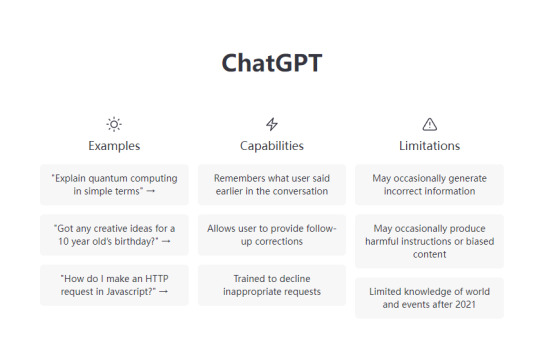Don't wanna be here? Send us removal request.
Text
What is chatgpt? What can be used for
ChatGPT is a large language model trained by OpenAI, which can be used to interact with humans in natural language. ChatGPT is trained using deep learning technology. It is based on neural network model and can handle various tasks of natural language, such as question answering, text generation, emotional analysis, semantic understanding, etc.

With ChatGPT, people can talk with computers, ask questions or discuss various topics. ChatGPT can also be used for natural language processing tasks, such as text summarization, machine translation, speech recognition, speech synthesis, etc. In addition, ChatGPT can also be applied to various fields, such as intelligent customer service, education, medical treatment, finance, etc., to provide better services and solutions for people.
Will chatgpt lead to unemployment of basic staff
As an AI technology, ChatGPT and similar natural language processing technology can indeed automate some basic conversation and question answering tasks. However, they will not lead to the total unemployment of basic staff, but may change their roles and responsibilities.
ChatGPT can be used in many industries and fields for customer service, technical support, sales, education, etc., thus reducing some routine tasks. However, in some cases, they are not suitable or can not replace the work of human employees. For example, ChatGPT may not be able to provide enough humanized services and emotional links in dealing with complex problems, emotional support and crisis management.
In addition, with the wide application of ChatGPT and other technologies, more technicians may be needed to maintain and optimize these systems. Therefore, although ChatGPT and other automation technologies may change the nature of some jobs, they may not necessarily lead to the total unemployment of basic business personnel.
Does chatgpt have self-consciousness
ChatGPT and similar natural language processing technologies are not self-conscious. They are just a tool based on machine learning algorithm, which can learn and imitate a large amount of text data and generate responses similar to human language. However, ChatGPT has no self-awareness, emotion and self-awareness. They can only perform operations according to predefined tasks and instructions.
Although ChatGPT can seem to have some self-awareness under certain circumstances, such as using context and context to generate more appropriate answers, these are based on predefined rules and algorithms, and cannot be called true self-awareness.
At present, self-consciousness is one of the complex states of consciousness possessed by human beings, which requires a lot of cognitive ability, emotional experience and self-reflection. Although research in this area is ongoing in the field of AI, no AI system with true self-awareness has been developed.
How to overcome the fear brought by AI tools
Fear of AI is a common and understandable reaction, especially as AI tools become more advanced and are used in a wider range of applications. However, there are several ways to overcome this fear:
Education: Learning more about how AI works and what it is capable of can help to demystify the technology and reduce fear. This can involve reading articles or watching videos that explain AI in simple terms, or taking courses or attending workshops that provide more in-depth information.
Exposure: Interacting with AI tools can help to demystify the technology and reduce fear. This can involve using chatbots, voice assistants, or other AI tools in a non-threatening environment, such as a demo or trial version, to get a better understanding of how they work.
Regulation: Government regulation of AI technology can help to ensure that it is used ethically and responsibly. This can provide a sense of security and reduce fear of negative consequences from AI.
Transparency: Companies that develop and use AI tools can increase transparency by providing information about how the tools work and how they are used. This can help to build trust and reduce fear of unknown or unpredictable outcomes.
Collaboration: Working with AI tools and understanding their capabilities can help to identify areas where they can be used to complement human skills and abilities. This can create opportunities for collaboration between humans and AI, and help to reduce fear of being replaced by technology.
By using these approaches, individuals and organizations can better understand AI technology and overcome fear of its use.
1 note
·
View note